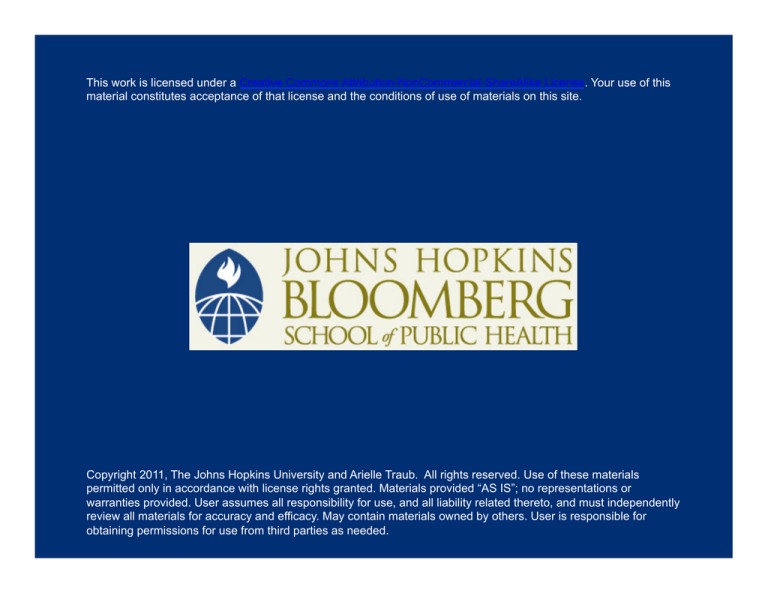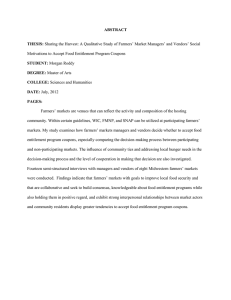
This work is licensed under a Creative Commons Attribution-NonCommercial-ShareAlike License. Your use of this
material constitutes acceptance of that license and the conditions of use of materials on this site.
Copyright 2011, The Johns Hopkins University and Arielle Traub. All rights reserved. Use of these materials
permitted only in accordance with license rights granted. Materials provided “AS IS”; no representations or
warranties provided. User assumes all responsibility for use, and all liability related thereto, and must independently
review all materials for accuracy and efficacy. May contain materials owned by others. User is responsible for
obtaining permissions for use from third parties as needed.
Farmers Markets as a Healthy
Food Access Strategy
Assessing Baltimore’s Farmers
Markets & Proposing
Recommendations to Increase
Access
Arielle Traub
May 14, 2011
MPH Capstone Symposium
Capstone Advisor: Roni Neff, PhD, MS
Objectives
• Provide background on Baltimore’s food
environment and the Farmers Market
Assessment
• Discuss key Assessment findings
• Highlight limitations of farmers market as a
food access strategy
• Provide recommendations to increase the
use of federal nutrition benefits at farmers
markets
Lead Up to Farmers Market
Assessment
• Formation of Baltimore’s Food Policy Task
Force formation
• Released 10 Recommendations
– “Promote and expand farmers markets”
Assessment Overview
• Objective #1: Are
underserved communities
being served?
• Objective #2:Do underserved
communities have equal
access to farmers markets?
• Objective #3: Are vendors at
farmers markets located in or
near food deserts profitable?
Federal Nutrition Programs
• Supplemental Nutrition Assistance Program
(SNAP)
– $130 FY10 average monthly benefit level in MD
• WIC Farmers Market Nutrition Program (WIC
FMNP)
– $20 for 2011 season in MD
• Senior Farmers Market Nutrition Program
(SFMNP)
– $30 for season in MD
Assessment Summary: FMNP
• 9 markets accept FMNP
– 5 in food deserts, 4 in non-food deserts
• SFMNP
– 88% Redemption Rate in 2010
• WIC FMNP
– 39% Redemption Rate in 2010
Assessment Summary: SNAP
• 3 markets accept SNAP
– 2010 Maryland Hunger Solutions Pilot
Program
• Infrastructure and incentive program
Factors Affecting Farmers Market
Access
•
•
•
•
•
•
Operational limitations
Cost perceptions
Demand for produce and healthy eating
Acceptance of FMNP/SNAP
Location to public transportation
Awareness
Recommendations for Increasing SNAP/
FMNP Redemption at Farmers Markets
• Research on adequate funding levels to
improve demand
• Federal investment in EBT infrastructure
– Incentive program funding
•
•
•
•
Encourage 100% FMNP Authorization
Community partnerships
Awareness campaigns
Encourage farmers to sell culturally-relevant
produce
Conclusion
• Farmers markets have a lot of potential as
food access sites
• Increase number of farmers markets
participating in federal benefits program
• Increase consumer awareness and
demand
• No magic bullet but a community benefit to
utilize as an intervention strategy
References
Slide 3: “Map of Baltimore”
Center for a Livable Future. http://www.jhsph.edu/clf/
Dale, D. (2009). Comparison of the availability of healthy foods in low income and high income
neighborhoods in Philadelphia. Ethnicity & Disease, 19: 82-83.
Franco, M., Diez-Roux, A. V., Nettleton, J. A., Lazo, M., Brancati, F., Caballero, B., et al. (2009).
Availability of healthy foods and dietary patterns: The multi-ethnic study of
atherosclerosis. American Journal of Clinical Nutrition, 89:897-904.
Franco, M., Diez-Roux, A. V., Glass, T. A., Caballero, B., Brancati, F. L. (2008). Neighborhood
characteristics and availability of healthy foods in Baltimore. American Journal of
Preventive Medicine, 35(6), 561-567.
French, S. A., Story, M., & Jeffery, R. W. (2001). Environmental influences on eating and
physical activity. Annual Review of Public Health, 22, 309-335.
Morland, K., Diez Roux, A. V., & Wing, S. (2006). Supermarkets, other food stores, and
obesity: The atherosclerosis risk in communities study. American Journal of
Preventive Medicine, 30(4), 333-339.
Story, M., Hamm, M. W., & Wallinga, D. (2009). Food systems and public health:
Linkages to achieve healthier diets and healthier communities. Journal of Hunger &
Environmental Nutrition, 4(3&4), 219-224.
Slide 4: “Lead Up”
Baltimore City Food Policy Task Force. (2009, December). Final report and recommendations.
Retrieved January 26, 2011, from
http://cleanergreenerbaltimore.org/uploads/files/Baltimore%20City%20Food%20Policy%20 Task
%20Force%20Report.pdf
References
Slide 7: Federal Nutrition Programs
United States Department of Agriculture. Supplemental Nutrition Assistance Program: Average
monthly benefit per person. Retrieved May 4, 2011, from http://www.fns.usda.gov/pd/
18SNAPavg$PP.htm
United States Department of Agriculture. Senior Farmers Market Nutrition Program. Retrieved
April 28,
2011, from http://www.fns.usda.gov/wic/seniorFMNP/
SFMNPFY2009Profile.htm
United States Department of Agriculture. WIC Program: WIC Farmers Market Nutrition
Program. Retrieved April 28, 2011, from
http://www.fns.usda.gov/wic/fmnp/fmnpfaqs.htm#8
Slide 8-9: Assessment Overview
Kaiser, C. (2011). Farmers’ market EBT pilot project: Baltimore City. Power point presented at
Maryland Hunger Solutions, Baltimore, MD.
Unpublished Baltimore City Farmers Market Assessment data. Winter 2010.
References
Slide 10: Factors Affecting Farmers Market Access
Briggs, S., Fisher, A., Lott, M., Miller, S., & Tessman, N. (2010). Real food, real choice: Connecting
SNAP recipients with farmers markets. Venice, CA: Community Food Security Coalition &
Cockeysville, MD: Farmers Market Coalition.
D. C. Hunger Solutions. (2007, August). Food Stamps accepted here: Attracting low-income
consumers to farmers’ markets. Page 15. Retrieved March 23, 2011, from
http://www.dchunger.org/pdf/foodstampsacceptedhere.pdf
Fisher, A. (1999, January). Hot peppers and parking lot peaches: Evaluating farmers’ markets in
low income communities. Venice, CA: Community Food Security Coalition. Retrieved
February 16, 2011, from http://www.foodsecurity.org/HotPeppersPeaches.pdf
Glanz, K., Basil, M., Maibach, E., Goldberg, J., Snyder, D. (1998). Why Americans eat what they do:
Taste, nutrition, cost, convenience, and weight control concerns as influences on food
consumption. Journal of the American Dietetic Association, 98(10), 1118-1126.
Neff, R. A., Palmer, A. M., McKenzie, S. E., & Lawrence, R. S. (2009). Food systems and public health
disparities. Journal of Hunger & Environmental Nutrition, 4, 282-314.
Racine, E. F., Vaugh, A. S., & Laditka, S. B. (2010). Farmers’ market use among African-American
women participating in the Special Supplemental Nutrition Program for Women, Infants,
and Children. Journal of the American Dietetic Association, 110(3), 441-446.
Stokols, D. (1992). Establishing and maintaining healthy environments. American Psychologist, 47(1),
6-22.
Acknowledgements
Amanda Behrens
Mia Cellucci
Amy Crone
Holly Freishtat
Jamie Harding
Roni Neff
Ethan Prosnit
Sarah Rodman
All of the Baltimore farmer market managers and city
and state officials who gave their time during the
assessment process
Assessment Summary—FMNP
• 9/14 markets accept FMNP
FMNP Participation Rates 2010
Coupons
MD SFMNP
81,825
Baltimore City SFMNP
44,300
MD WIC FMNP
234,996
Baltimore City WIC
56,850
FMNP
FMNP Redemption Rates 2010
Coupons
MD SFMNP
67,097
Baltimore City SFMNP
38,984
MD WIC FMNP
110,448
Baltimore City WIC
22,172
FMNP
% of Total
100%
54%
100%
24%
% of Total
82%
88%
47%
39%






